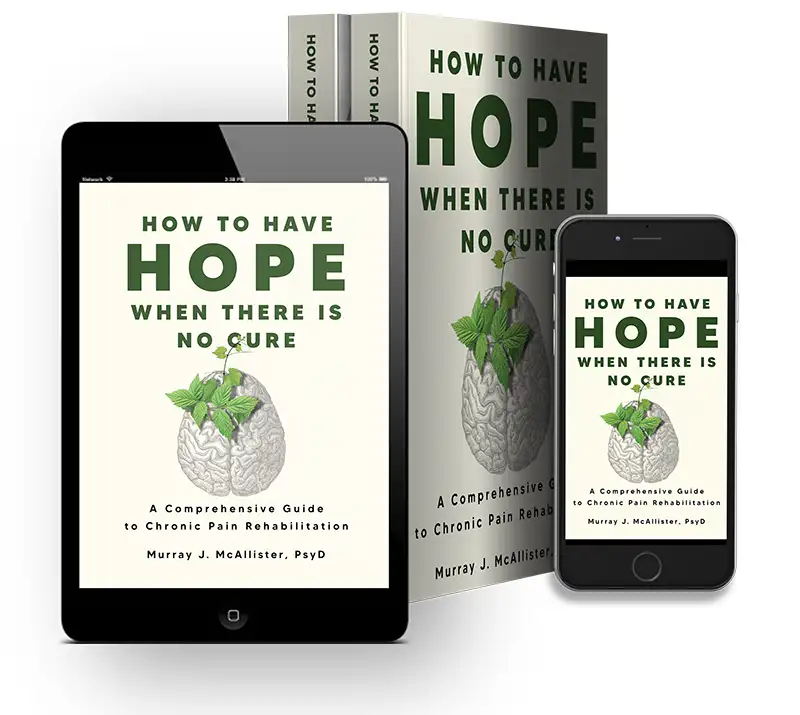
You can find the hardcover, paperback, and ebook versions here or wherever you buy your books
The Institute has provided those living with chronic pain, their family members and their providers evidence-based digestible information about chronic pain for over ten years. We are pleased to be publishing How to Have Hope When There Is No Cure: A Comprehensive Guide to Chronic Pain Rehabilitation. This groundbreaking book is the culmination of decades of work by our late founder, Dr. Murray J McAllister, PsyD, and serves as the pinnacle of our mission; to make pain management more effective by changing the culture of how chronic pain is treated. With the publication of this book, we will no longer be adding new content to our website or social channels, but current content will remain available.Murray J. McAllister, PsyD
Murray J. McAllister, PsyD, is a pain psychologist and consults to health systems on improving pain. He is the editor and founder of the Institute for Chronic Pain (ICP). The ICP is an educational and public policy think tank. In its mission is to lead the field in making pain management more empirically supported, the ICP provides academic quality information on chronic pain that is approachable to patients and their families.
While clinical lore is that perfectionists are more prone to the development of chronic pain, it may just be that perfectionists are more likely to seek care for their chronic pain. Reason? Perfectionists with chronic pain are more prone to behavioral exacerbations of pain as well as anxiety and depression. Let’s see how.
A Healthcare Educational System
Coping gets short shrift in our healthcare system. We don’t spend a lot of time or money on it. Instead, we devote the vast majority of our healthcare resources to various procedures and medications that attempt to cure conditions, or at the very least attempt to get rid of the symptoms that on-going health conditions cause. We hardly spend any time or money on what patients themselves can do to keep the conditions from disrupting their lives.
The Biopsychosocial Nature of Pain
Contexts matter. The same joke might go over in very different ways, depending on whether it’s told by a comedian in front of an audience at a comedy club or told by an applicant in the middle of a job interview. An action done over and over again might be considered in one context an admirable example of perseverance in the face of adversity, whereas in another context it might be considered an exercise in futility.
Why We Do What We Do
The Institute for Chronic Pain has a new content page on our website entitled: Why Healthcare Providers Deliver Ineffective Care. As is our custom, we announce such additions to the website on our blog and provide a little introduction to it. The content on this new page of the website is particularly important to me because providing content like it is one of the reasons why I founded the Institute. It’s not too far of a stretch to say that it’s why we do what we do. By way of introduction, then, I’d like to explain.
Ending the Stigma of Pain: A New ICP Webpage
The stigma of chronic pain is personally hurtful. It is a negative judgment of you that others make. Specifically, stigma occurs when others judge you simply for being who you are – someone with chronic pain. You are looked down upon because of it. As such, stigma is more than hurtful. It’s shaming.
Follow Us Now on Twitter
You can now follow the Institute for Chronic Pain on Twitter! Check us out at:
On all our social media sites, we add content daily on news, blogs, and sites that are related to chronic pain.
Stress, Inflammation and Chronic Pain
People with chronic pain know that they tend to have a pain flare when they are under stress. They are, however, sometimes sensitive to acknowledge it aloud for fear that others might think that their pain is all in the head. Nonetheless, the fact that stress makes pain worse is entirely normal and common. It is a natural product of how we are made.
Why the Stigma of Chronic Pain Remains
Attempts to challenge the stigma of chronic pain often fail. Despite arguments from providers and patients alike, stigma remains a persistent problem.
All or nothing thinking is one of the most common, problematic ways of coping with pain. It’s right up there with catastrophizing, fear-avoidance, and refusing to accept the chronicity of pain. All of these problems prevent people from coping with pain well and being able to live a full life despite having chronic pain. Since we have reviewed the other problematic ways of coping with pain in previous posts, let’s discuss all or nothing thinking today.
A Webpage Worth the Read
Those of you who are connected to one of our social media sites know that we tend to post daily on the latest news and research in the field of chronic pain management. We recently came across a description of cognitive behavioral therapy for chronic pain on the web, which we initially thought we’d send out on one of our daily posts. After finding myself reading it for a second time, however, I thought that it was too good to simply send out on social media without more comment than the usual line or two of introduction that we tend to provide.
-
Opioid Tapering as an Exposure-based Therapy for Chronic Pain
“Thank you. I’m so grateful to all of you. You’ve given me my life back… but why did it take so long for me to be referred to this program?” This series of statements, along with the concluding question, is… -
What is Cognitive Behavioral Therapy for Pain?
Cognitive behavioral therapy is a traditional form of therapy that is used for a great many types of health conditions. Historically beginning in the 1970’s, it was first used as treatments for chronic pain and depression,1, 2 but later applied to… -
Why See a Psychologist for Pain?
People are sometimes surprised that there are psychologists who are not mental health providers. It’s also true for people with persistent pain who might wonder why their physician referred them to a psychologist for the management of pain. ‘I’m not… -
Whatever Happened to Backache?
You’d think that we’d all agree on what back pain is. Pain in the low back is almost as common as days of the week. Most everyone has had or will have back pain in the course of their lives… -
Should the Definition of Opioid Addiction Change?
Twenty some odd years ago, the American Academy of Pain Medicine and the American Pain Society, two large pain-related professional organizations, teamed up to agree upon what it means to have both chronic pain and be addicted to opioid pain…



